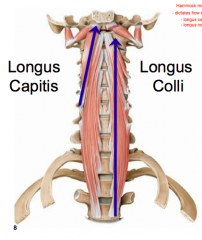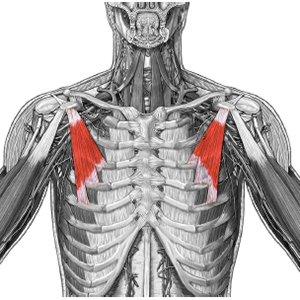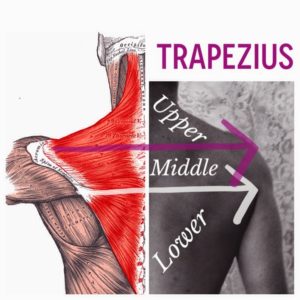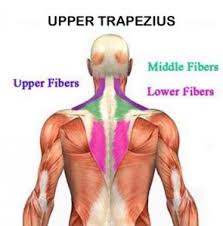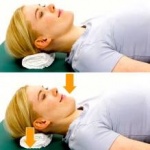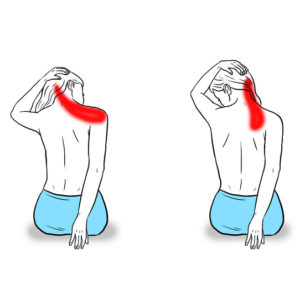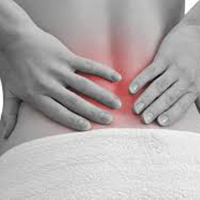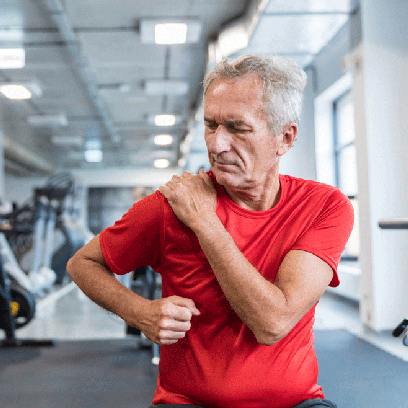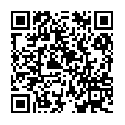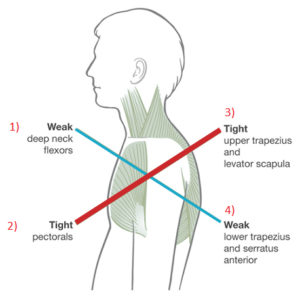
Upper Crossed Syndrome and chronic pain (UCS). The imbalance of four key muscle groups underlies many cases of headache, neck and upper back pain.
Upper back and neck pain is epidemic in our culture. It has surpassed low back pain as the number one chronic pain complaint. Most of us have this pain to some degree.
For others, their pain interferes with work and pleasure, but still allows them to function. At times, it can be completely debilitating for some.
A series of physicians specializing in chronic pain and rehabilitation noticed some common patterns in this type of pain. Dr. Vladimir Janda was the first to called this combination of symptoms ‘Upper Crossed Syndrome’.
He came up with that name after observing the combination of hunching, shoulder rounding and head forward posture in his patients. Their primary complaints ranged from headaches to pain in the upper back, neck, shoulders, arms and hands. But the complex of muscles underlying these problems was often the same.
When looked at from the side, Dr. Janda divided the shoulder girdle into four quadrants and drew an X across them. In normal individuals, the muscles in these four groups were balanced. However, in Janda’s patients, there was a characteristic pattern of muscles that were too tight and muscles that were too weak. Countless physcians and therapists have confirmed that relationship between Upper Crossed Syndrome and Chronic Pain.
It is understandable that we focus on the locations that are typically painful:
- Back of the neck
- Upper back and area in between the shoulder blades
- Upper traps and shoulders
- Headaches
Muscles that impact these areas are all strained by head forward posture and rounding of the shoulders. Over time, this changes the position of our head, neck and shoulders. In addition, most of us have restricted range of motion of our arm at the shoulder and in our neck.
Knowing the relationship between Upper Crossed Syndrome and Chronic Pain helps us treat all the relevant muscles.
In a word, Upper Crossed Syndrome and Chronic Pain is about posture. Posture is the way in which we hold our bodies, both at rest and in motion.
Over time, holding our upper body in positions that are incorrect, leads to significant distortions in our posture. It can become difficult or impossible to simply, ‘sit up straight’ or ‘stop slouching’. We need a real method. The patterns of UCS help us devise a better approach.
For instance, we can’t simply pull our shoulders back because often our chest is too tight. So we must release that tension first. We can’t center our head over our body effectively if the wrong muscles are flexing our neck and pulling it forward. And we can’t ground our shoulders and relieve the tension our our upper traps if our lower traps aren’t active enough to support it.
Upper Crossed Syndrome Characteristics
Upper Crossed Syndrome and Chronic Pain develop due to specific muscular imbalances.
The upper front quadrant of muscles are the front of the neck. Janda noticed that in Upper Crossed Syndrome the Deep Cervical Flexors are inhibited or weak. Often the SCM muscle becomes too engaged and tight from subsituting for the neck flexors. We don’t usually notice any of this.
The lower front quadrant is represented by our pec minor. This small, but important, chest muscle actually attaches to the front of our shoulder. It pulls our shoulder forward and causes rounding.
The lower rear quadrant includes muscles we seldom think about – our serratus anterior and lower traps. These are depressors of our shoulder. However, these muscles are active when we work with our hands OVER our head, rather than down in front of us. So, it is not surprising that our the shoulder depressors gradually become weak and inhibited.
The upper rear quadrant includes the elevators of the shoulders like upper trapezius and levator scapula. These muscles are too engaged and tight (locked short) from using our hands out in front of us. At the same time, other upper back muscles like our rhomboids and middle traps are pulled tight (locked long) by our pecs. These muscles are where most of our neck and upper back pain lives.
The upper front quadrant of muscles are the front of the neck. Janda noticed that in Upper Crossed Syndrome the Deep Cervical Flexors are inhibited or weak. Often the SCM muscle becomes too engaged and tight from subsituting for the neck flexors. We don’t usually notice any of this.
The lower front quadrant is represented by our Pectoralis Minor. This small, but important, chest muscle actually attaches to the front of our shoulder. It pulls our shoulder forward and causes rounding.
The lower rear quadrant includes muscles we seldom think about – our serratus anterior and lower traps. These are depressors of our shoulder. However, these muscles are active when we work with our hands OVER our head, rather than down in front of us. So, it is not surprising that our the shoulder depressors gradually become weak and inhibited.
The upper rear quadrant includes the elevators of the shoulders like upper trapezius and levator scapula. These muscles are too engaged and tight (locked short) from using our hands out in front of us. At the same time, other upper back muscles like our rhomboids and middle traps are pulled tight (locked long) by our pecs. These muscles are where most of our neck and upper back pain lives.
Upper Crossed Syndrome and Chronic Pain Treatment.
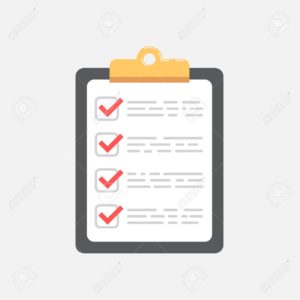
From the outset, education is important. It is our job as therapists to educate you about our assessment and our process. Then, throughout our treatment, we continue this education process.
Trigger Point Therapy can get at some aspects of myofascial pain that you might not have thought of!
Diaphragmatic breathing is at the foundation of myofascial trigger point treatment. But, if you don’t know how to do it, we will teach you. On the other hand, if you already know about it, we will help you deepen the technique.
Of course, the medications and supplements you are taking matter too. Typically, reducing drug consumption is a good thing. However, it should be done gradually and in consultation with your physician.
Unfortunately, sleep posture and sleep disturbances contribute to many myofascial pain syndromes. However, understanding this is especially important for relief from chronic pain. Because of this, we always have a thorough discussion about how you sleep during an initial assessment.
Structural variations need to be explored and understood. Once treatment begins, they can be accomodated or corrected in various ways.
It is surprising, but most of us our not taught proper body mechanics. Whether we are at home or at work, we need to learn how to use our body correctly.
Most people are self-conscious about their posture. And, posture includes more than how you sit or stand. But, identifying the postural aspects that should be improved is a challenge. Even harder, is understanding how they vary with movement. Ultimately, devising a strategy for improving them is essential.
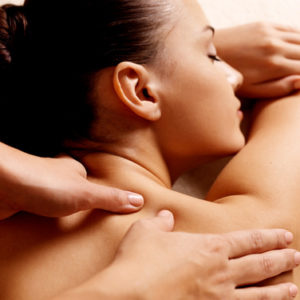
However, it usually takes more than hands on work to really erase the pain and keep it away.
First, the chances are that we were not your first stop. As a general rule of thumb, the longer you have experienced pain, the longer it will take to make them go away.
Secondly, there are usually at least some factors that affect your pain that we can’t easily change. However, we can usually find the most important factors and devise a strategy together.
Myofascial tigger point therapy – it’s how you work this!
Education is the first step in the myofascial treatment protocol.
Sometimes, we may not be good enough at explaining how myofascial pain works and how it activates your pain.
However, we believe that people can make more progress when they know more about their condition. So, we try to understand what your learning style is give you as much information as you want – but hopefully not too much!
Typically, we performing series of miniature cycles of test/assess, treat and test/assess again. It is an informed exploration for both of us.
We have an initial assessment from your history, postural and range of motion exams, etc. Then, we use various treatment techniques before testing and assessing again.
Manual Therapy Techniques
First, we specifically expertly use manual pressure release therapy, neuromuscular techniques, and deep stroking, friction, skin rolling. When indicated, we also use fascial stretching. Sometimes, we use less common techniques like cupping, spray and stretch and acoustic compression.
Muscle Activation
In addition, we may also use active and passive muscle activation techniques. This includes reciprocal inhibition, postisometric relaxation, contract/relax, strain/counter-strain and muscle energy techniques. Sometimes, we also use hot/cold therapy.
Range of Motion/Testing
Finally, routinely run the muscle we are treating through its entire, pain-free range of motion. This is part of your treatment. However, it also the start of a new test/assess cycle.
We learn together whether your range of motion has increased and whether your pain is reduced. We may have you get up and use your body in the way that causes pain to ‘test’ more dynamically.
As we finish our hand-on work, we transition into learning new movement strategies and self-care.
Myofascial tigger point therapy – it’s how you work this!
Upper Crossed Syndrome – Myofascial Self-Care

| #1 | Use gentle “pincer” compression on SCM muscle on front of neck as instructed (compensates for longus capitis/colli – weak) |
| #2 | Use tennis balls between upper/outer pec arising off of ribs and doorframe, using multiple arm positions (pec minor – tight) |
| #3 | Use backknobber on back of shoulder, upper trap and crook of neck (mid/upper traps, levator scapula – tight) |
| #4a | Use tennis balls on area between lower inside corner of shoulder blades and spine (lower trapezius – weak) |
| #4b | Use tennis balls between your side/ribs and the wall as instructed (serratus anterior – weak) |
| #1 | Seated neck extension stretch (tight SCM inhibits longus capitis/colli – weak) |
| #2a | One arm doorway stretch (pec minor – tight) |
| #2b | Passive stretches over foam roller laying from sacrum to head (pec minor – tight) |
| #3 | Fixed arm side neck stretches (upper trap, levator scapula – tight) |
| #4 | None – (Weak) |
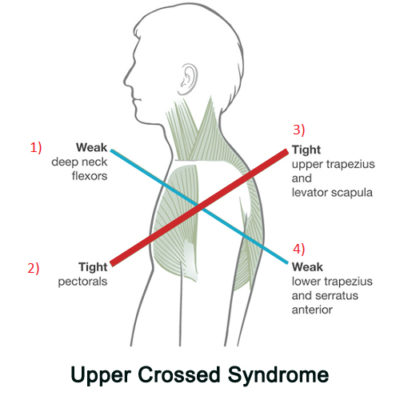
Professional Treatment With Us
Take some time. Treat yourself. You deserve it.
Book a treatment this month and receive 20% off a three session package.
Janet was great. FANTASTIC person who knew how to treat and deal with my conditions. Very informative. Finally, someone who knew what I was talking about.
Really Good
It was interesting, and helpful for my IT band and hip
My experience was wonderful. Janet was very kind and attentive. I felt great after my session and would recommend to try it out.
The lady that assisted me was awesome! I suffer from fibromyalgia and when I left I felt like a brand new person! I plan to return when I get time!
Janet was great - knowledgeable and she found all my "hot spots."
Seriously, if you are looking for massage therapy that actually does your body good--that changes its function for the better and actually makes pain go away--then this is the place you need to come. Not Massage Envy. Not a chiropractor. You need trigger point from knowledgeable experts in the craft.
If your have pain in any part of your body this is the place to go. It focus on the muscles where the pain is. you will feel like a new person. Awesome will be returning. Thanks nice friendly and attentive
amazing!!!
I felt so much better after my appointment. Thank you and thanks for the self care tips!
Experienced therapist. Feel great after appointment...
Highly recommended!
What a great experience. The provider was able to recommend things I can do to improve my pain. Address issues I didn't even share with her that she was able to tell just by her exam and treating me for what i went for. Will be back. Feeling grateful
I spent so much money on chiropractors. This is much better. Everybody should try it out.
Beautiful, relaxing setting. Therapist was knowledgable and professional. I'll be going back. Thank you.
Janet is very informative. I loved that she explained which muscles/groups she was working on. I learned a lot about my posture and why some of my muscles are not activating. She also provided me with a list of considerations and excercises to improve my posture. I will be back!
Janet has a unique gift and talent in trigger point therapy. I’m definitely seeing her again!
I loved my experience. Janet is extremely knowledgeable in a vary wide variety of conditions. She is thorough and attentive. Makes you feel right at home!
It's like an hour of physical therapy (the good parts of P.T. where they massage you and stretch you). She also takes time to explain some ways to help your specific issues. Highly recommend!
Janet is very knowledgeable and informative. She thoroughly explains where you have weakness and what muscles are over compensating. She gives exercises, stretches, or everyday changes you can make to help you are progress on your own. I highly recommend a visit!
Janet was very knowledgeable and never in a hurry. She took her time explaining every little detail, great service
Felt much better after the trigger point massage, highly recommend.
Excellent
What About My Pain?
Clearly, everyone is different. Many of us have additional challenges and complications. Naturally, we tailor our treatment plans to the individual. However, there are common foundations in this work with everyone.
Fortunately, if you are having similar issues, you may find that a just few treatment sessions helps! We will identify and treat root causes of your individual case.
Clearly, everyone is different. Many of us have additional challenges and complications. Naturally, we tailor our treatment plans to the individual. However, there are common foundations in this work with everyone.
We are licensed professionals. In addition, we all have additional training and certifications in advanced techniques. For instance, this includes trigger point therapy, fascial stretching, neuromuscular and movement therapy. Also we offer kinesio taping, myofascial release, cupping, acoustic compression, self-care classes and more. In fact, we often combine several of these techniques into a single session..
Of course, no one wants chronic pain! Fortunately, can work together with you to help sort out the issues.
Click here or all us at 630-858-0000 today to make an appointment!
More info at: WestSubPainRelief.com
You can also take a picture of this QR code with another phone and share or view the entire article:
If reading from a pdf or printout, you will find links and videos at: https://WestSubPainRelief.com/upper-crossed-syndrome-chronic-pain-neck-upper-back

